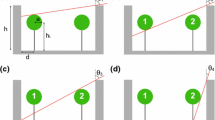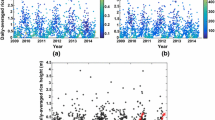Abstract
In this paper, a generalized layered model for radiation transfer in canopy with high vertical resolution is developed. Differing from the two-stream approximate radiation transfer model commonly used in the land surface models, the generalized model takes into account the effect of complicated canopy morphology and inhomogeneous optical properties of leaves on radiation transfer within the canopy. In the model, the total leaf area index (LAI) of the canopy is divided into many layers. At a given layer, the influences of diffuse radiation angle distributions and leaf angle distributions on radiation transfer within the canopy are considered. The derivation of equations serving the model are described in detail, and these can deal with various diffuse radiation transfers in quite broad categories of canopy with quite inhomogeneous vertical structures and uneven leaves with substantially different optical properties of adaxial and abaxial faces of the leaves. The model is used to simulate the radiation transfer for canopies with horizontal leaves to validate the generalized model. Results from the model are compared with those from the two-stream scheme, and differences between these two models are discussed.
Similar content being viewed by others
References
De Wit, C. T., 1965: Photosynthesis of leaf canopies. Agricultural Research Reports. No. 663, Pudoc, Wageningen, The Netherlands, 57pp.
Dickinson, R. E., 1983: Land surface processes and climate-surface albedos and energy balance. Advances in Geophysics, 25, Academic Press, 305–353.
Dickinson, R. E., and Coauthors, 2002: Nitrogen controls on climate model evapotranspiration. J. Climate, 15, 278–295.
Dickinson, R. E., A. Henderson-Sellers, P. J. Kennedy, and M. F. Wilson, 1986: Biosphere Atmosphere Transfer Scheme (BATS) for the NCAR Community Climate Model. NCAR Technical Note, NCAR, TN275+STR, 69pp.
Goudriaan, J., 1977: Crop Micrometeorology: A Simulation Study. Centre for Agricultural Publishing and Documentation, Wageningen, The Netherlands, 249pp.
Grace, J., 1971: The directional distribution of light in natural and controlled environment conditions. Journal of Applied Ecology, 8, 155–165.
Huang Hongfeng, 1997: Interaction and Simulation Study of Soil, Plant and Atmosphere. China Meteorological Press, Beijing, 309pp. (in Chinese)
Jiang Youxu, 1996: A study of the structure and function of forest ecosystems in China. The Metaphase Article Collection of the Major Program of the National Science Foundation of China, China Forestry Publishing House, Beijing, 380pp. (in Chinese)
Lemeur, R., 1973: A method for simulating the direct solar radiation regime in sunflower, Jerusalem artichoke, corn and soybean canopies using actual stand structure data. Agricultural and Forest Meteorology, 12, 229–247.
Meador, W. E., and W. R. Weaver, 1980: Two-stream approximations to radiative transfer in planetary atmospheres: A unified description of existing methods and a new improvement. J. Atmos. Sci., 37, 630–643.
Mesarch, M. A., E. A. Walter-Shea, and C. J. Hays, 1998: BOREAS TE-12 Leaf Optical Data for SSA Species. Data set. Oak Ridge National Laboratory Distributed Active Archive Center, Oak Ridge, Tennessee, U.S.A. [Available on-line at http://www.daac.ornl.gov]
Myneni, R. B., V. P. Gutschick, G. Asrar, and E. T. Kanemasu, 1988: Photon transport in vegetation canopies with anisotropic scattering. Agricultural and Forest Meteorology, 42, 1–40.
Myneni, R. B., J. Ross, and G. Asrar, 1989: A review on the theory of photon transport in leaf canopies. Agricultural and Forest Meteorology, 45, 1–153.
Monsi, M., and T. Saeki, 1953: The light factor in plant communities and its significance for dry matter production. Japanese Journal of Botany, 14, 22–52.
Monteith, J. L., 1973: Principles of Environmental Physics. Edward Arnold, 241pp.
Moon, P., and D. Spencer, 1942: Illumination from a nonuniform sky. Transactions of the Illuminating Engineering Society, 37, 707–726.
Norman, J. M., 1980: Interfacing leaf and canopy light interception models. Predicting Photosynthesis Production and Use for Ecosystem Models, Vol. II., J. D. Hesketh and J. W. Jones, Eds., CRC Press, Boca Raton, Florida. 49–67.
Norman, J. M., 1979: Modeling the complete canopy. Modification of the Aerial Environment of Crops. B. J. Barfiled and J. F. Gerber, Eds., American Society of Agricultural Engineers, St. Joseph,. Michigan, 249–277.
Norman, J. M., and P. G. Jarvis, 1975: Photosynthesis in sitka spruce (picea sitchensis (bong.) carr.). V. Radiation penetration theory and a test case. Journal of Applied Ecology, 12, 839–878.
Ross, J., 1981: The Radiation Regime and the Architecture of Plant Stands. Dr. W. Junk, Publishers, The Netherlands, 391pp.
Ross, J. 1975: Radiative transfer in plant communities. Vegetation and Atmosphere, J. L. Monteith, Ed., Academic Press, 13–52.
Sellers, P. J., 1985: Canopy reflectance, photosynthesis and transpiration. Int. J. Remote Sens., 6, 1335–1372.
Sellers, P. J., and Coauthors, 1996a: A revised land surface parameterization (SiB2) for atmospheric GCMs. Part I: Model formulation. J. Climate, 9, 676–705.
Sellers, P. J., S. O. Los, C. J. Tucker, C. O. Justice, D. A. Dazlich, G. J. Collatz, and D. A. Randall, 1996b: A revised land surface parameterization (SiB2) for atmospheric GCMs. Part II: The generation of global fields of terrestrial biophysical parameters from satellite data. J. Climate, 9, 706–737.
Sellers, P. J., Y. Mintz, Y. C. Sud, and A. Dalcher, 1986: A simple biosphere model (SiB) for use within general circulation models. J. Atmos. Sci., 43, 505–531.
Wang Hanjie, and Wang Xinli, 1999: Principles and Techniques on the Biological Boundary Layer. China Meteorological Press, Beijing, 211pp. (in Chinese)
Wohlfahrt, G., M. Bahna, U. Tapperiner, and A. Cernusca, 2000: A model of whole plant gas exchange for herbaceous species from mountain grassland sites differing in land use. Ecological Modelling, 125, 173–201.
Author information
Authors and Affiliations
Rights and permissions
About this article
Cite this article
Dai, Q., Sun, S. A generalized layered radiative transfer model in the vegetation canopy. Adv. Atmos. Sci. 23, 243–257 (2006). https://doi.org/10.1007/s00376-006-0243-7
Received:
Revised:
Issue Date:
DOI: https://doi.org/10.1007/s00376-006-0243-7




